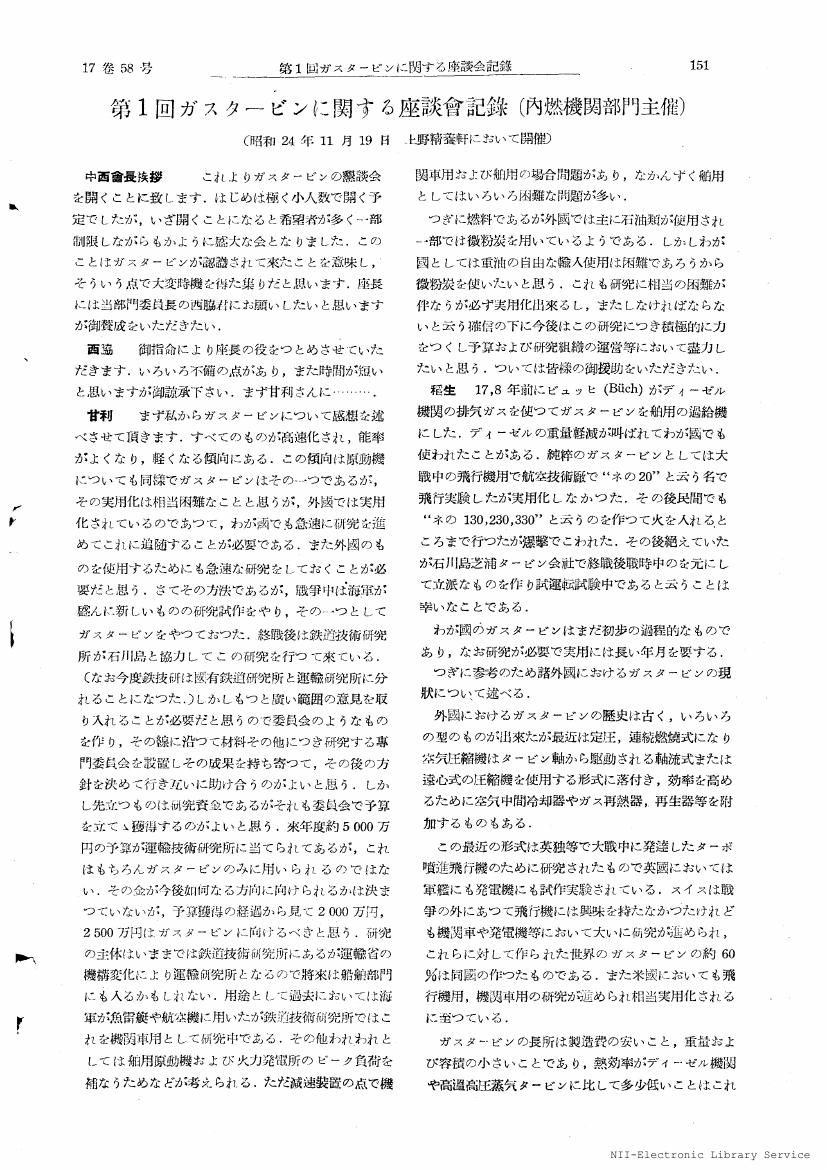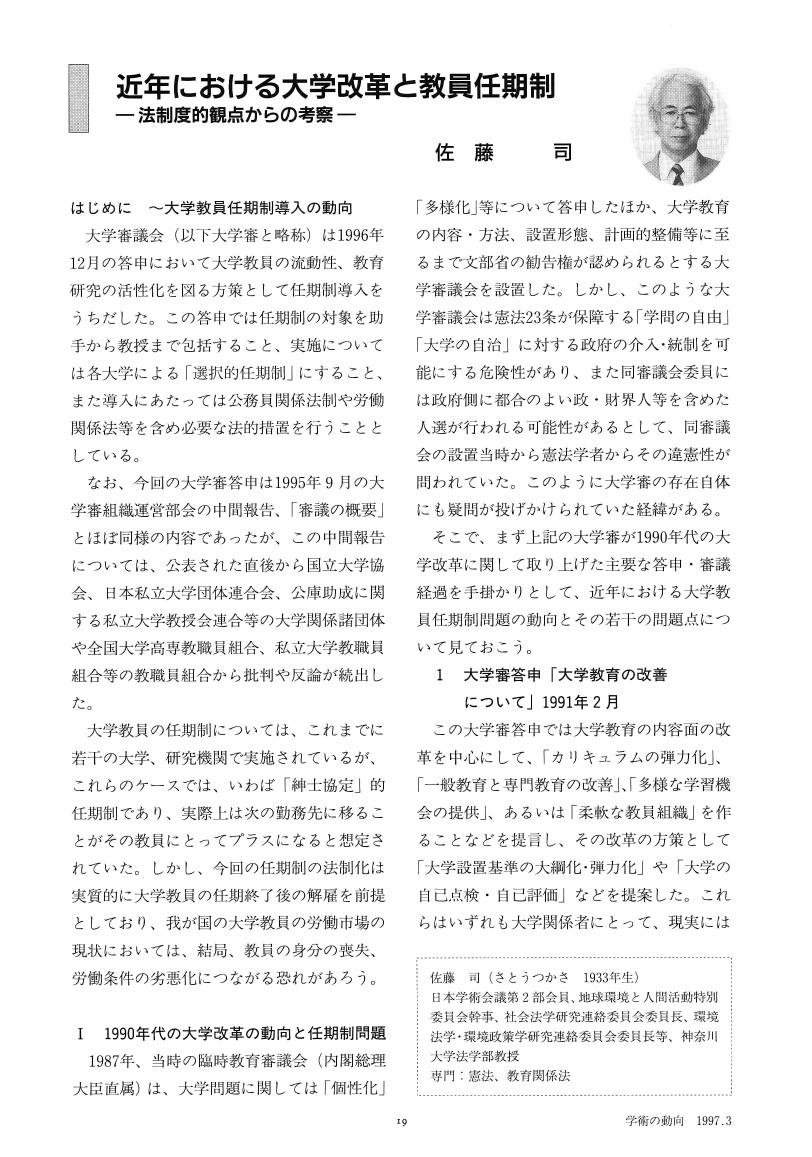6 0 0 0 OA 女性による酒造り報告
- 著者
- 坂本 裕子
- 出版者
- 公益財団法人 日本醸造協会
- 雑誌
- 日本醸造協会誌 (ISSN:09147314)
- 巻号頁・発行日
- vol.91, no.10, pp.728-730, 1996-10-15 (Released:2011-09-20)
6 0 0 0 OA 新編武蔵風土記稿
- 出版者
- 内務省地理局
- 巻号頁・発行日
- vol.巻之176 高麗郡之1,巻之177 高麗郡之2,巻之178 高麗郡之3,巻之179 高麗郡之4,巻之180 高麗郡之5,巻之18, 1884
- 著者
- 大橋 忠将 有山 ゆり 早川 惠理 長沢 美樹 杉山 徹
- 出版者
- 一般社団法人 日本糖尿病学会
- 雑誌
- 糖尿病 (ISSN:0021437X)
- 巻号頁・発行日
- vol.59, no.6, pp.407-413, 2016
49歳男性.鍼治療後14日で僧帽筋膿瘍,DKA(血糖値643 mg/dL,pH 6.916,総ケトン体20600 <i>μ</i>mol/L)を生じ,意識障害で当院に救急搬送となった.抗菌薬投与,デブリードマン,局所陰圧閉鎖療法(negative pressure wound therapy:NPWT)にて膿瘍の治療を行い,糖尿病に関しては強化インスリン療法で血糖管理した.感染及び血糖値改善後は基礎インスリン投与と経口血糖降下薬の併用療法(basal-supported oral therapy:BOT)に変更して血糖管理を継続した.もともと無治療の糖尿病(HbA1c 15.1 %)による易感染性があり,鍼治療を契機にして僧帽筋膿瘍,感染に伴うDKAを生じたと考えられた.管理不良の糖尿病の存在下では,鍼治療のような侵襲的医療行為により感染症が引き起こされる危険性があり,注意が必要である.
- 著者
- 由井 寅子
- 出版者
- 日本未病システム学会
- 雑誌
- 日本未病システム学会雑誌 (ISSN:13475541)
- 巻号頁・発行日
- vol.14, no.2, pp.306-309, 2009-03-05 (Released:2010-09-09)
- 参考文献数
- 9
6 0 0 0 OA 第1回ガスタービンに関する座談會記録 : 内燃機関部門主催
- 著者
- 甘利 〓一 磯貝 誠 稲生 光吉 大塚 誠之 大塚 芳郎 大塚 新太郎 河田 三治 後藤 清太郎 佐藤 豪 佐藤 忠雄 柴田 万壽太郎 栖原 豊太郎 須之部 量寛 棚沢 泰 種子島 時休 玉木 福宜 土光 敏夫 中西 不二夫 永野 治 長尾 不二夫 西脇 仁一 沼知 福三郎 林 貞助 久野 五十男 福山 勉 藤井 澄二 堀越 博 松永 陽之助 村井 等 森 糾明 矢木 栄 山内 正男 吉水 直一
- 出版者
- 一般社団法人 日本機械学会
- 雑誌
- 日本機械学會論文集 (ISSN:00290270)
- 巻号頁・発行日
- vol.17, no.58, pp.151-174, 1951-01-30 (Released:2008-03-28)
- 著者
- 島村 恭則
- 出版者
- 国立歴史民俗博物館
- 雑誌
- 国立歴史民俗博物館研究報告 (ISSN:02867400)
- 巻号頁・発行日
- vol.103, pp.325-348, 2003-03
本論文では、都市民俗学の立場から、喫茶店、とりわけそこで行なわれるモーニング(朝食を、自宅ではなく、喫茶店のモーニングセット〈モーニングサービス〉でとる習慣)という事象に注目し、記述と問題点の整理を行なった。本論中で行ないえた指摘は、およそ次のとおりである。(1)モーニングが行なわれる理由は、①労力の軽減、②単身者の便宜、③コミュニケーション、のうちのどれか、あるいはそれらの複合に求められる。(2)日本におけるモーニングは、豊橋以西の、中京圏、阪神圏、中四国のそれぞれ都市部、とりわけ工業地帯の下町的な地域に分布しているものと見ることができる。(3)モーニングは、一九六〇年代後半から行なわれるようになっていると見られる。その場合、喫茶店経営者側は、出勤前のサラリーマンへのサービスを意図してモーニングセット/サービスを開始したのであったが、これが地域で受容される際には、地の生活者、とりわけ女性たちの井戸端会議の場としての機能を果たすようになっている。(4)アジア的視野で眺めた場合、都市社会においては、朝食を外食するほうが一般的だといってよいくらいの状況が展開されており、日本のモーニングには、アジア都市社会に共通する生活文化としての性格が存在するといっても過言ではない。(5)モーニングの場は、他者と他者とが場を共有しながら、そこでさまざまな言葉を交わす公共圏であるが、そこで語られるのは、決して論理的に整理された明晰な言葉ではない。むしろ、モーニングの場は、そうした論理的な言葉で形成される「市民的公共圏」からは排除される言説あるいは人々が交流する場として存在するのであり、この空間は市民的公共圏に対する「もう一つの公共圏」として位置づけることができる。In the study of folklore, i.e., in the study of urban folklore, there is a growing accumulation of studies on various types of living space that exist in the city. However, there have not yet been any folklore studies made on the subject of the coffee house. The coffee house is, needless to say, a place to eat and drink, but from the point of view of folklore studies, it can be pointed out that there is more to the coffee house than its role in providing a place for eating and drinking.This paper focuses on the coffee house, especially on the phenomenon of the "morning set" (the habit of eating the "morning set" at a coffee house instead of having breakfast at home), defining the phenomenon and arranging the issues. The comments made in the paper are as follows.1) The reasons that people have a "morning set" are one or more of the following: a) to save effort, b) because it is convenient for single people, and c) for communication.2) The "morning set" in Japan can be seen in urban areas west of Toyohashi, i.e., in cities in the Chukyo (Nagoya), Hanshin (Osaka and Kobe), or Chushikoku (Chugoku and Shikoku) regions, particularly in the old downtown areas of industrial zones.3) The "morning set" is thought to have come into existence in the late 1960s. At that time, the coffee house owners had begun providing the "morning set" or "morning service" for salaried workers who stopped by on their way to work; however, as the idea was accepted into the community it began to serve as a meeting place for the people, especially women, of the community to get together and talk.4) If we look at the whole of Asia, in urban society it is almost more widespread to take breakfast outside the home, and it can be said that the Japanese "morning set" contains an aspect of life and culture that is universal all across Asian urban communities.5) The venue of the "morning set" is a communal space where strangers share the same space and exchange words with each other, but the words that are exchanged there are never theoretically sound, clearly defined logical arguments. Rather, in the case of the "morning", the coffee house exists as a place to meet people and exchange opinions that are excluded from the "citizens' communal space" which is made up of logical arguments. Therefore, one might regard the "morning set" venue as "another communal space" as compared to the "citizen's space".
6 0 0 0 OA パスファインダー:「LGBT」について調べる
- 著者
- 国立女性教育会館情報課
- 巻号頁・発行日
- 2020-12
長辺とじ両面印刷し、中心で縦折にしてご利用ください。
6 0 0 0 OA 天然物からの抗結核薬の探索と展望
- 著者
- 五十嵐 雅之
- 出版者
- 公益社団法人 日本農芸化学会
- 雑誌
- 化学と生物 (ISSN:0453073X)
- 巻号頁・発行日
- vol.54, no.1, pp.37-42, 2015-12-20 (Released:2016-12-20)
- 参考文献数
- 38
3大感染症(エイズ,マラリア,結核)および顧みられない熱帯病(Neglected Tropical Diseases: NTDs, 17疾患群)は,患者の多くが途上国に偏在するため,先進国で爆発的に蔓延したエイズを除き,長い間新薬研究開発の対象としては顧みられてこなかった.近年,これら3大感染症およびNTDsに対し革新的な新薬をより効率的に開発し蔓延国に供給する目的で,国際機関,各国政府あるいは官民が連携し研究開発の支援組織が発足している(1).この支援のもとで国際的に新薬の開発が進められているが,なかでも天然物からの治療薬探索は有用かつ革新的な新薬を開発しうるアプローチとして大きな期待を受けている.この分野で先駆的な成功を収めた大村らに2015年のノーベル医学生理学賞が授与されることもその期待の表れと言えよう.大村らが発見した放線菌Streptomyces avermitilisの生産するエバーメクチン(avermectin)の誘導体イベルメクチン(2)(ivermectin,図1)が線虫に起因するオンコセルカ症などの治療薬として開発され,またTuらによりマラリア治療薬としてアルテミシニン(3)(artemisinin,図1)が植物成分より単離されいずれも有用性の高い革新的な新薬として使用されている.本稿では,3大感染症の一つである結核の治療薬の開発状況を天然物の視点で紹介したい.
6 0 0 0 OA 福岡県のと畜場に搬入された馬にみられた肝臓灰白色硬結節と多包虫感染との関連性
- 著者
- 一二三 達郎 池田 加江 江藤 良樹 井河 和仁 西村 耕一 小川 卓司 川口 博明 三好 宣彰
- 出版者
- 日本獸医師会
- 巻号頁・発行日
- vol.68, no.4, pp.253-257, 2015 (Released:2015-07-06)
2012年7月から12月の6カ月間に福岡県のと畜場に搬入された馬610頭中53頭において肝臓に灰白色硬結節が認められた。硬結節の病理組織学的及び遺伝子検査を実施し,多包虫の感染状況を調査した。これらの検査結果から,39頭が多包虫症と診断された(感染率6.4%)。過去に報告されている軽種馬だけでなく,ポニー種,日本輓系種,北海道和種などのさまざまな品種で多包虫感染が確認された。疫学調査では,4頭が多包虫症の有病地である北海道での飼養歴が確認され,北海道で感染した可能性が考えられた。一方で,本研究の多包虫感染馬の多くは北海道での飼養歴は不明であり,これらの馬は感染地の特定が困難であった。しかし,日本での多包条虫の地理的分布や馬の生産状況を考慮すると,これらの馬も北海道で感染した可能性を完全には否定できないと思われた。
6 0 0 0 OA <特別寄稿>都?つくばの成立環境
- 著者
- 谷口 守
- 出版者
- 筑波大学大学院環境科学研究科
- 雑誌
- 環境科学研究科年報 : 環境科学セミナー
- 巻号頁・発行日
- no.17, pp.122-123, 1994-11
6 0 0 0 OA 近年における大学改革と教員任期制
- 著者
- 佐藤 司
- 出版者
- 公益財団法人 日本学術協力財団
- 雑誌
- 学術の動向 (ISSN:13423363)
- 巻号頁・発行日
- vol.2, no.3, pp.19-24, 1997-03-01 (Released:2009-12-21)
- 著者
- 西河内 靖泰
- 出版者
- 図書館問題研究会
- 雑誌
- みんなの図書館 (ISSN:03860914)
- 巻号頁・発行日
- no.268, pp.31-43, 1999-08
6 0 0 0 OA 日知録集釋卷一譯注
- 著者
- 伊東 倫厚
- 出版者
- 北海道大學文學部 = The Faculty of Letters, Hokkaido University
- 雑誌
- 北海道大學文學部紀要 (ISSN:04376668)
- 巻号頁・発行日
- vol.38, no.3, pp.1-119, 1990-03-30
6 0 0 0 OA 脳梗塞とヘパリン起因性血小板減少症
- 著者
- 山本 晴子 宮田 茂樹
- 出版者
- 日本神経学会
- 雑誌
- 臨床神経学 (ISSN:0009918X)
- 巻号頁・発行日
- vol.51, no.5, pp.316-320, 2011 (Released:2011-05-27)
- 参考文献数
- 14
- 被引用文献数
- 1 1
ヘパリン起因性血小板減少症(HIT)は,血小板減少を特徴とする免疫的機序による症候群で,発症頻度は低いものの,ヘパリン投与に合併して多彩な血栓・塞栓症をひきおこす重篤な疾患である.急性期脳梗塞治療の現場では,様々な血管内治療の開発にともない大量のへパリンが使用される局面が増加しつつあり,HITについての知識が求められている.急性期脳梗塞におけるHIT発症割合に関する報告はきわめて少ない.われわれの施設での後ろ向き調査では,HITの発生割合は0.5%と推測された.さらに多施設共同前向き調査の結果では1.7%であった.HITを発症したばあいの予後は不良であるため,HITがうたがわれたばあいには早急に治療を開始すべきである.
6 0 0 0 OA 短信
- 出版者
- 国立国会図書館
- 雑誌
- 外国の立法 : 立法情報・翻訳・解説 (ISSN:13492071)
- 巻号頁・発行日
- vol.(月刊版. 287-1), 2021-04
6 0 0 0 「瀧山千句」と三好長慶
- 著者
- 鶴崎 裕雄
- 出版者
- 中世文学会
- 雑誌
- 中世文学 (ISSN:05782376)
- 巻号頁・発行日
- vol.34, pp.84-91, 1989
6 0 0 0 OA 聚光院の成立時期についての一仮説―障壁画作期議論の前提として―
- 著者
- 綿田 稔
- 雑誌
- 美術研究 = The bijutsu kenkiu : the journal of art studies
- 巻号頁・発行日
- no.396, pp.25-44, 2008-11-05
Jukô-in was built as the family temple in memory of Miyoshi Nagayoshi (1522-64, posthumous name Jukô-indono, or Lord of Jukô-in) and is one of the sub temples of Daitoku-ji in Kyoto. The main hall of Jukô-in, built in the typical architectural style of the late Muromachi period, is extant. The paintings on the walls of the hall are thought to be essentially contemporaneous with the building and they too remain in good condition. Indeed, these paintings are considered one of the benchmark works of Kano Eitoku (1543-90), a painter who defined his age. In the past there has been an ongoing debate amongst painting historians as to the date of the construction of the Jukô-in main hall, with one faction backing a date of 1566 and another 1583. However, the restoration report that set off this dating debate states that construction of the hall lasted from the end of the Eiroku period (1558-69) through the beginning of the Tenshô era (1573-1591), and thus does nothing more than indicate that the foundation date is not limited to 1566. Watanabe Yûji, the proposer of the 1583 theory, considers that there is still ample room for a reconsideration of the 1566 theory, and thus his argument is nothing more than a statement that in the extreme, 1583 could be possible. In spite of these arguments, the Jukô-in clearly existed within Daitoku-ji as an organization in 1572, as Ogawa Hiromitsu has indicated. Further, if the extant main hall dates to 1583, then it must be imagined that its state indicates that it was moved from another site or was rebuilt. However, at this point in time there has been no report of the existence of any proof or documentary support for such a state of affairs. Further, judging from the state of the inscription, 1583 might be the date in which the previous cypress-bark roof of the main hall was changed to a tile roof. Thus it is important to note that there is no evidence to confirm either hypothesis, and further, that in the Eiroku era there is no trace of the residence of either Shôrei Sôkin (1505-83), founding priest of Jukô-in, or his teacher Dairin Sôtô (1480-1568) at Jukô-in. It may be that 1566 marked the founding not of Jukôô-in, but rather that of its predecessor. Another possibility is that the founding of such a temple was conceived of in 1566 and later this date was taken as its honorary foundation date. Up until now there has been no definitive historical document directly linked to the creation of the Jukô-in main hall, and in the end, both the 1566 and the 1583 arguments remain without solid documentary evidence or circumstantial proof. At this stage, no matter what date is proposed as a production date for the Jukô-in wall panel paintings, given that there are no definitive dated inscriptions on the paintings itself, there is nothing that can extract us from a state of “nothing can be said.” This author took a critical stance against the 1583 hypothesis in the exhibition review included below, and in this forum seeks a sense of direction in argument from the previously introduced information on the subject. The conclusion of this search finds that the date of 1571 can be proposed as the actual completion date of the Jukô-in main hall, based on the situation surrounding the commissioner of the Jukô-in, Miyoshi Yoshitsugu (1551-73), and the date of the portrait of Shorei Sôkin with self-colophon written in the Jukô-in main hall. It is similarly highly likely that the wall panel paintings can also be attributed to that year.
6 0 0 0 豊臣秀頼の作事体制について
- 著者
- 木村 展子
- 出版者
- 日本建築学会
- 雑誌
- 日本建築学会計画系論文集 (ISSN:13404210)
- 巻号頁・発行日
- vol.63, no.511, pp.185-192, 1998
- 参考文献数
- 83
Hideyori constructed a lot of temples and shrines. Investigation into munahuda and bokushomei of these temples and shrines makes clear the character of sakuzi structure of Hideyori. Among them, the forms of sakuzi projects are divided into two. One is carpenters and craftman dispatched by Toyotomi performed sakuzi(A), and the other is carpenters belonging each temples and local carpenters performed it as the main constituents(B), with the money and magistrates of Toyotomi. By examining the forms of sakuzi projects by Hideyori, it's found that form(A) was taken in many cases with active mobilization, but form(B) also existed widely. And the chief carpenter who generally direct the sakuzi project like Nakai Masakiyo did not exist. It suggests the limit of sakuzi structure of Hideyori and it is doubtful it worked entirely as an organization.



